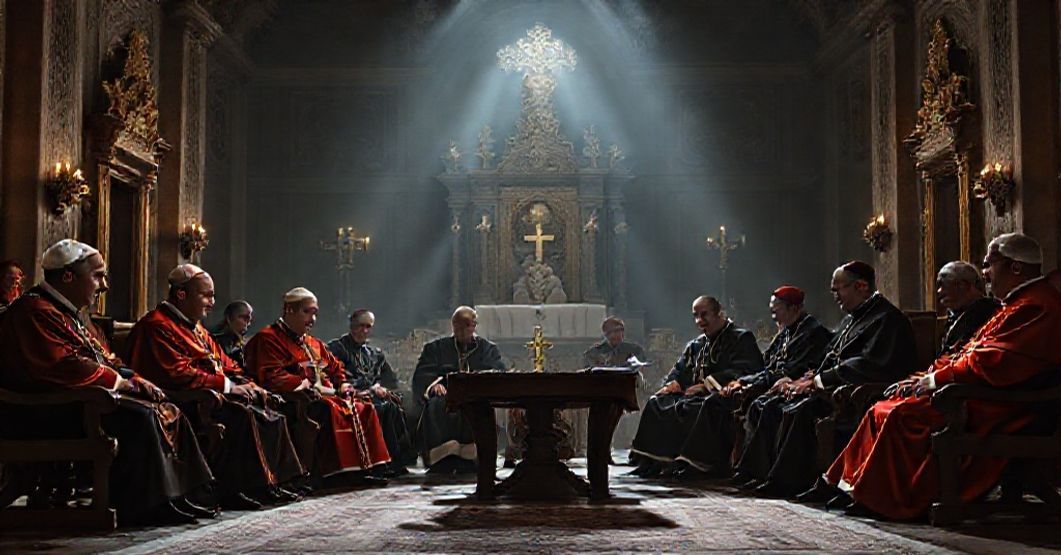German Bishops’ Roman Colloquium: Syncretism Masquerading as Ecclesial Reform
German Bishops’ Roman Colloquium: Syncretism Masquerading as Ecclesial Reform
EWTN News reports on the fourth meeting between representatives of the conciliar sect’s Roman apparatus and the German Episcopal Conference regarding plans for a “synodal conference.” The November 12, 2025 encounter, described as occurring in an “honest, open, and constructive atmosphere,” discussed the proposed body’s “character, composition, and competencies.” Participants included antipope Leo XIV’s key collaborators—Cardinals Parolin, Fernández, Koch, and Roche—alongside German bishops led by Georg Bätzing. Notably, Bishop Stefan Oster attended as a “guest,” despite his prior criticisms of the German Synodal Way. This theatrical dialogue perpetuates the conciliar sect’s systematic demolition of Catholic ecclesiology.
Naturalism Replaces Supernatural Mission
The very premise of establishing a “synodal conference” exposes the conciliar sect’s complete abandonment of the Church’s divine constitution. Quas primas (Pius XI, 1925) unambiguously declares Christ’s kingship over all societies, with the Church as His visible kingdom on earth: “The Church, instituted by Christ as a perfect society, has a natural and inalienable right to perfect freedom and immunity from the power of the state” (§23). Yet the proposed body—a hybrid of lay committees and dissident clergy—reduces the Church to a human organization debating “competencies” rather than upholding immutable truths.
The article’s silence on doctrinal matters speaks volumes. Nowhere does it mention the salvation of souls, fidelity to revelation, or defense against heresy—the very raison d’être of ecclesiastical authority. Instead, the focus remains fixated on structural tinkering, echoing the condemned proposition: “The Church is not a true and perfect society, entirely free” (Syllabus of Errors, Pius IX, §19).
Linguistic Subversion of Ecclesial Reality
The carefully crafted language—”honest, open, constructive atmosphere”—serves as verbal anesthesia to numb Catholics to the gravity of the betrayal. When Cardinal Fernández, architect of the heretical declaration Fiducia Supplicans, participates in “dialogue” about Church governance, we witness the fulfillment of Pius X’s warning: “Modernists place the foundation of religious philosophy in that doctrine which is usually called Agnosticism” (Pascendi Dominici Gregis, §6).
The term “synodal conference” itself constitutes a terminological fraud. Having abandoned the initially proposed “synodal council” due to Roman pressure, the German rebels simply rebranded their schismatic project. This mirrors the Masonic strategy of incrementalism documented in the False Fatima Apparitions file: “Stage 3 (1958-2000): Takeover of the narrative by modernists, concealment of the Third Secret, ecumenical reinterpretation.”
Theological Apostasy Institutionalized
Bätzing’s persistence in promoting this body despite multiple Roman interventions demonstrates the conciliar sect’s fundamental incoherence. The Second Council of Lyons (1274) dogmatically defined that “the Holy Roman Church possesses full supremacy and principality over the whole Catholic Church… to which all must submit” (Denzinger 466). Yet here we see bishops—nominally subordinate to Rome—negotiating terms for a parallel governing structure.
This rebellion finds its roots in the heresy of collegiality propagated by Vatican II’s Lumen Gentium, which contradicts the defined truth that “the Roman Pontiff alone has the right to govern the universal Church” (Council of Florence, Denzinger 694). The presence of Cardinal Roche—who oversees the destruction of liturgy—alongside Cardinal Koch—tasked with dismantling doctrinal boundaries through false ecumenism—reveals the meeting’s true purpose: to codify the German Church’s formal secession from Catholic tradition.
Oster’s Complicit Dissent
The inclusion of Bishop Oster as critical “guest” exemplifies the controlled opposition tactic. While Oster occasionally voices reservations about Synodal Way excesses, his participation legitimizes the broader apostasy. This mirrors the Lefebvrist error of seeking to “reform” an institution that has visibly abandoned its divine foundation. As the Defense of Sedevacantism file documents: “A manifest heretic cannot be Pope or a member of the Church” (Bellarmine, De Romano Pontifice). True resistance requires complete separation from the conciliar apparatus, not theatrical dialogues.
Symptomatic of Conciliar Revolution’s Final Stage
These negotiations represent the logical culmination of the hermeneutic of rupture. The Syllabus of Errors condemned the notion that “the Roman Pontiff can, and ought to, reconcile himself, and come to terms with progress, liberalism and modern civilization” (§80). Yet here we see antipope Leo XIV’s lieutenants doing precisely that—negotiating terms of surrender to German modernism.
The article’s concluding reference to Bätzing defending same-sex blessings despite papal criticism proves the bankruptcy of conciliar structures. When a “pope” condemns heresy yet keeps its proponents in communion, he confirms the sedevacantist thesis: “A heretic is not a member, therefore he cannot be the head of the Church” (John of St. Thomas). This pantomime of “dialogue” occurs while the German church collapses—Mass attendance below 10%, dioceses bankrupt, sacraments invalidated by intentional liturgical abuses.
Source:
Vatican, German bishops continue dialogue on synodal body (catholicnewsagency.com)
Date: 13.11.2025
